Top Marketing Agency Metrics & KPIs You Should Track in 2025
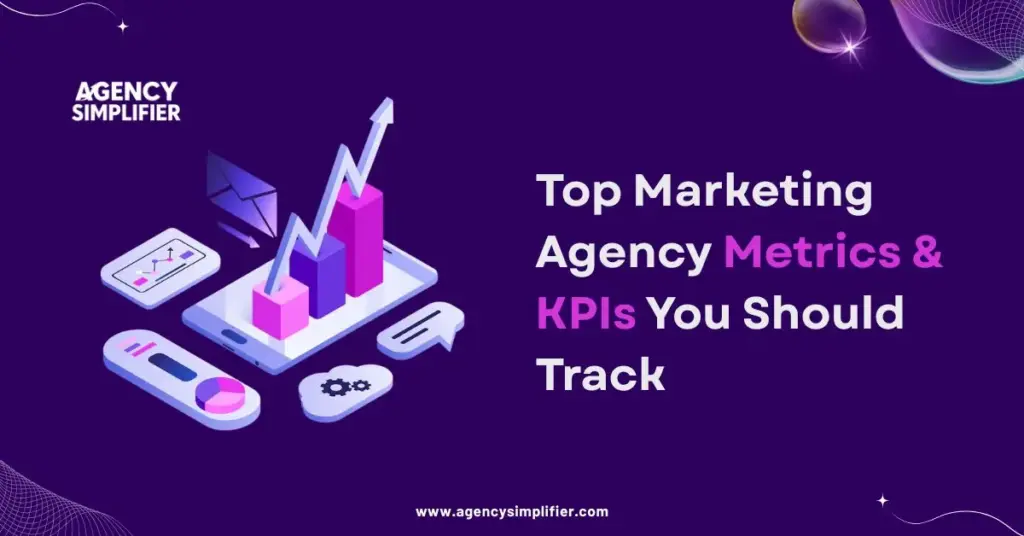
In 2025, data-driven decision making represents the fundamental differentiator between thriving marketing agencies and those struggling to survive. As client expectations reach unprecedented heights and competitive pressures intensify across all verticals, agencies must implement sophisticated measurement frameworks to demonstrate value, optimize performance, and accelerate growth.
This comprehensive guide examines the essential advertising agency metrics, agency KPIs, and agency performance metrics that define success in today’s dynamic marketplace. Whether you operate a specialized boutique consultancy or manage a full-service agency portfolio, understanding these critical measurement frameworks will transform your operational efficiency and client outcomes.
The modern agency landscape demands precision in performance tracking, strategic alignment between measurement and business objectives, and the ability to translate complex data into actionable insights that drive sustainable competitive advantage.
Why Metrics & KPIs Matter for Agencies
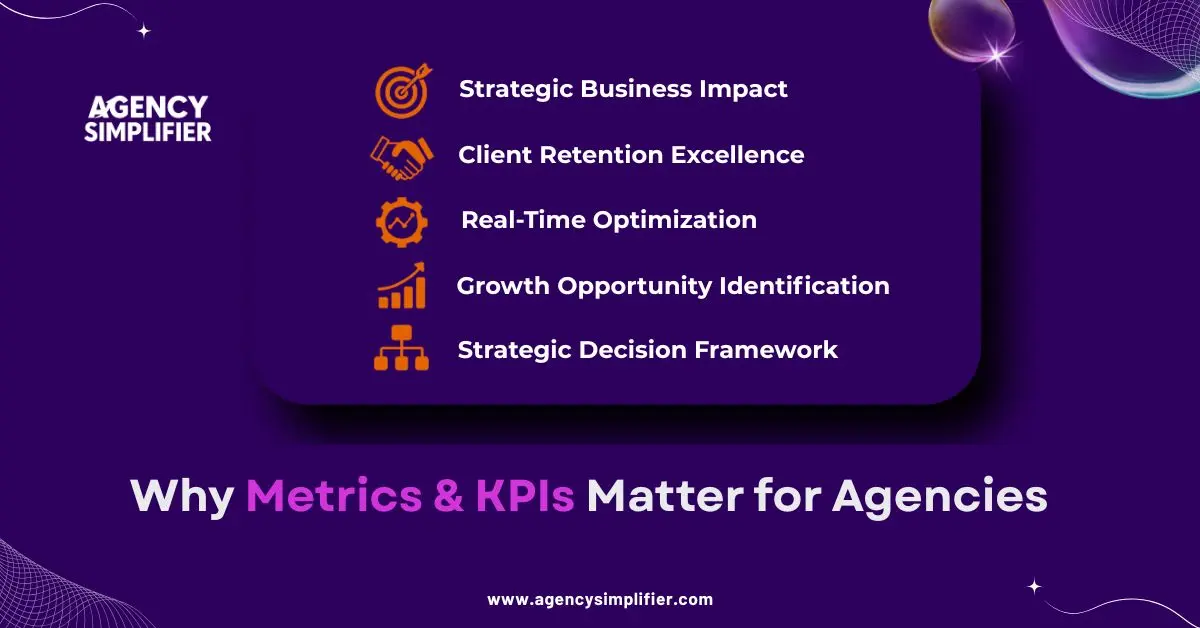
Agency metrics and KPIs serve as the operational foundation for sustainable business growth, enabling organizations to make informed decisions across multiple strategic dimensions. These measurement frameworks provide critical visibility into performance trends, resource allocation efficiency, and client satisfaction levels that directly impact long-term viability.
Strategic Business Impact:
- Client Retention Excellence: Demonstrate quantifiable ROI and campaign effectiveness through comprehensive performance documentation
- Real-Time Optimization: Enable immediate campaign adjustments and strategic pivots based on performance indicators
- Growth Opportunity Identification: Reveal operational inefficiencies and expansion possibilities through detailed analytics
- Strategic Decision Framework: Support informed business decisions with reliable data foundations
Top app development companies that neglect comprehensive agency performance metrics face significant operational risks, including unpredictable cash flow patterns, elevated client churn rates, missed growth opportunities, and resource misallocation. The absence of structured measurement systems creates blind spots that compromise competitive positioning and strategic planning capabilities.
Modern clients expect transparency, accountability, and measurable results from their agency partnerships. Organizations equipped with robust KPI tracking systems can provide detailed performance documentation while building stronger, more trusting client relationships based on demonstrated value delivery.
How to Choose the Right Agency KPIs
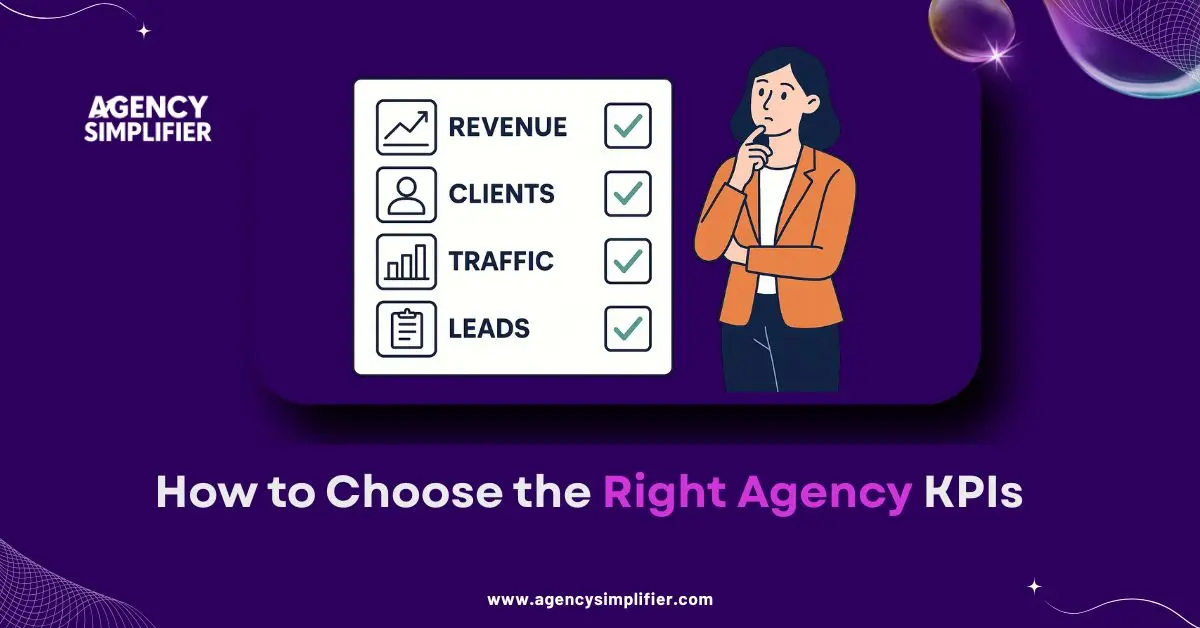
Selecting appropriate agency KPIs requires strategic alignment between measurement frameworks and core business objectives. Effective KPI selection follows a structured approach that considers agency specialization, client requirements, and growth trajectories.
Strategic Alignment Principles:
- Business-Client Goal Synchronization: Ensure selected KPIs directly impact agency growth metrics and client success outcomes
- Agency-Specific Customization: Adapt measurement frameworks to reflect unique service offerings, organizational size, and market positioning
- Balanced Indicator Integration: Implement comprehensive systems that incorporate both predictive leading indicators and outcome-focused lagging metrics
Agency type and specialization significantly influence optimal KPI selection. Full-service digital agencies require different advertising agency metrics compared to specialized SEO consultancies or social media management firms. Consider your core competencies, client expectations, and strategic priorities when developing measurement architectures.
Successful KPI frameworks balance forward-looking predictive metrics with historical performance validation. Leading indicators enable proactive decision-making and strategic adjustments, while lagging indicators confirm strategy effectiveness and provide accountability for results achieved.
Essential Agency Metrics & KPIs
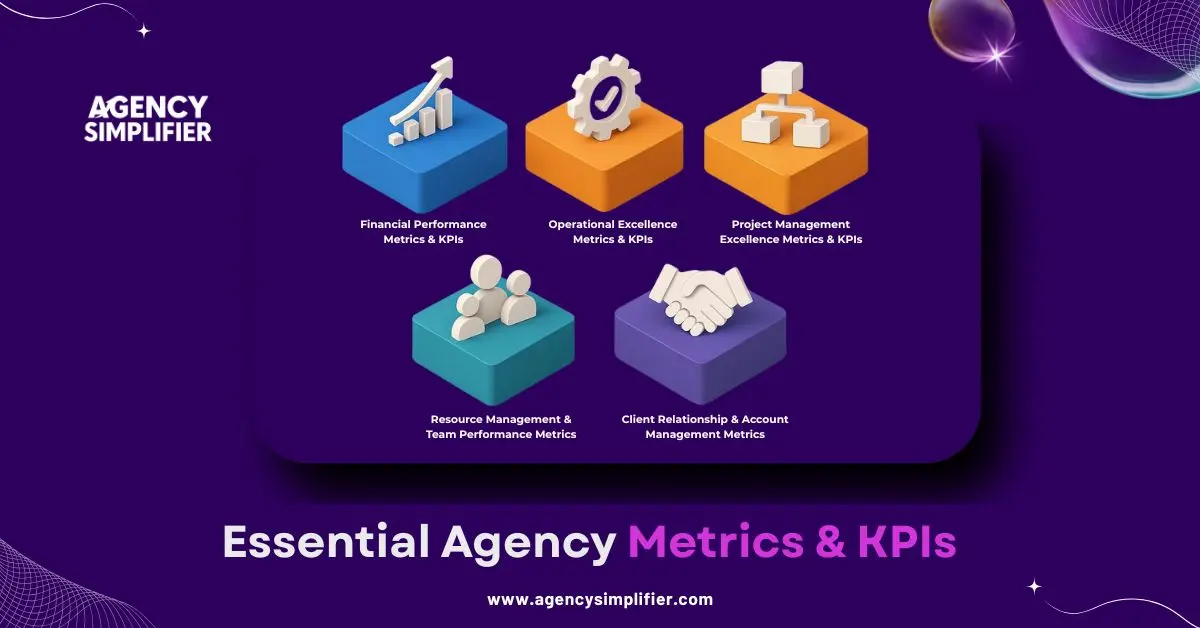
Financial Performance Metrics & KPIs
Financial metrics form the cornerstone of agency performance measurement, providing critical insights into profitability, growth sustainability, and operational efficiency.
Core Financial Indicators:
- Revenue Growth Rate: Measures sales momentum and market traction across specified time periods
- Gross Profit Margin: Evaluates profitability after direct service delivery costs and operational expenses
- Net Profit Margin: Reveals overall organizational profitability and financial health indicators
- Customer Acquisition Cost (CAC): Assesses efficiency and sustainability of new client acquisition strategies
- Return on Ad Spend (ROAS): Quantifies advertising investment effectiveness and campaign profitability
- Annual Recurring Revenue (ARR): Critical metric for agencies operating retainer-based or SaaS service models
- Cash Flow & Working Capital: Ensures operational stability and financial flexibility for growth investments
These financial agency KPIs provide essential visibility into business sustainability and enable informed strategic planning for expansion, investment, and resource allocation decisions.
Operational Excellence Metrics & KPIs
Operational metrics reveal internal efficiency levels and identify opportunities for process optimization and resource allocation improvements.
Key Operational Indicators:
- Operating Expense Ratio: Monitors cost control effectiveness and operational efficiency trends
- Accounts Receivable Turnover: Measures cash flow efficiency and client payment collection performance
- Project Delivery Timelines: Tracks on-time completion rates and project management effectiveness
- Utilization Rate: Calculates billable hours percentage against total available working hours
- Client Churn Rate: Indicates client retention performance and relationship management effectiveness
Operational agency performance metrics enable organizations to identify bottlenecks, optimize resource deployment, and improve overall service delivery quality while maintaining profitability targets.
Project Management Excellence Metrics & KPIs
Project-level measurement provides granular insights into service delivery efficiency, profitability analysis, and resource optimization opportunities.
Project Performance Indicators:
- Project Profitability Analysis: Measures individual project profit margins and contribution to overall business performance
- Project Margin Optimization: Tracks percentage profit margins across different project types and client segments
- On-Time Completion Rates: Evaluates delivery reliability and project management system effectiveness
- Budget Variance Analysis: Compares planned versus actual project expenditures for cost control optimization
- Resource Allocation Efficiency: Optimizes team deployment and skill utilization across concurrent projects
Resource Management & Team Performance Metrics
Human resource metrics provide insights into team productivity, satisfaction levels, and organizational capacity for growth and service delivery excellence.
Team Performance Indicators:
- Team Utilization Rates: Measures staff productivity and capacity optimization across service delivery functions
- Employee Satisfaction & Engagement: Impacts retention rates, productivity levels, and service quality outcomes
- Average Revenue per Employee: Gauges organizational efficiency and productivity benchmarking against industry standards
- Training & Development Investment: Supports skill advancement and capacity building for service expansion capabilities
Client Relationship & Account Management Metrics
Client-focused metrics reveal relationship health, growth potential, and long-term partnership sustainability indicators.
Client Success Indicators:
- Client Lifetime Value (CLTV): Calculates total revenue potential from individual client relationships over extended periods
- Client Satisfaction Metrics (NPS/CSAT): Measures loyalty levels and referral generation potential through satisfaction surveys
- Upsell & Cross-Sell Performance: Tracks revenue expansion opportunities within existing client relationships
- Client Retention Rates: Evaluates long-term relationship health and partnership sustainability metrics
Campaign Performance Metrics by Channel
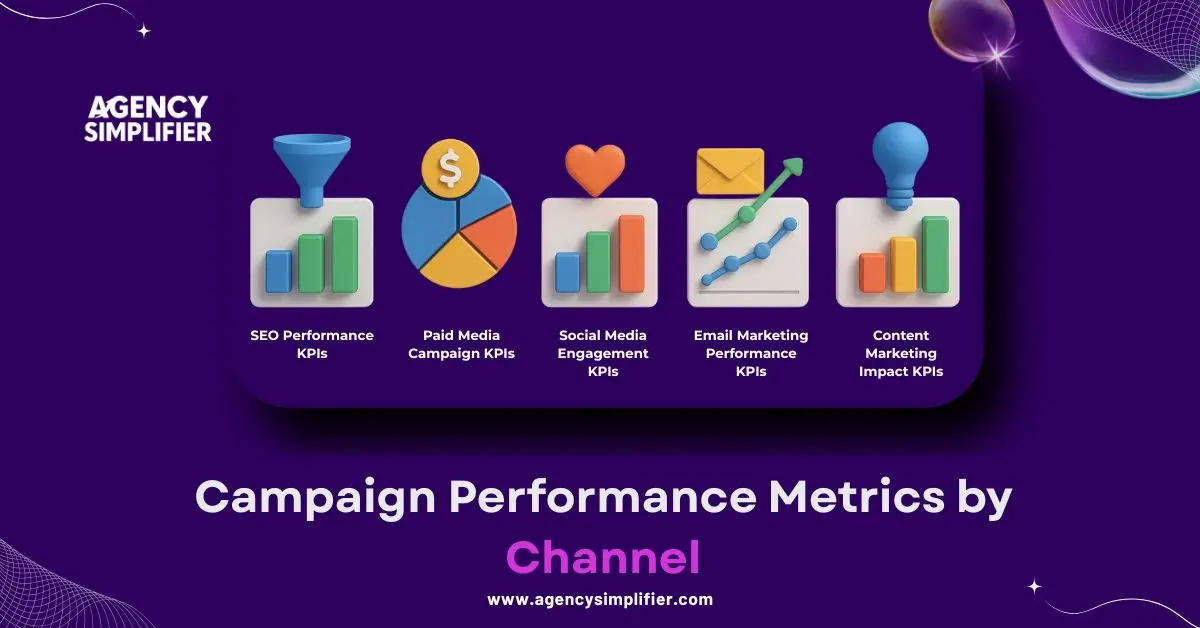
Channel-specific agency metrics provide detailed insights into marketing effectiveness across different platforms and service offerings.
SEO Performance KPIs:
- Organic traffic growth trajectories and keyword ranking improvements
- Backlink profile development and domain authority enhancement
- Organic click-through rates and conversion optimization metrics
- Search visibility improvements and competitive positioning analysis
Paid Media Campaign KPIs:
- Return on ad spend (ROAS) optimization and cost per acquisition metrics
- Click-through rates, conversion rates, and audience engagement analysis
- Cost per click management and bid optimization performance
- Campaign attribution and multi-touch conversion tracking
Social Media Engagement KPIs:
- Engagement rate optimization and community growth quality metrics
- Share of voice analysis and brand mention sentiment tracking
- Reach and impression metrics with conversion correlation analysis
- Social media-driven lead generation and conversion attribution
Email Marketing Performance KPIs:
- Open rate optimization and deliverability improvement metrics
- Click-through rate enhancement and list growth quality analysis
- Unsubscribe rate management and engagement retention strategies
- Email-driven conversion tracking and revenue attribution analysis
Content Marketing Impact KPIs:
- Time on page analysis and bounce rate optimization metrics
- Content-generated lead attribution and conversion tracking
- Social sharing performance and content amplification analysis
- Content marketing ROI and business impact measurement
Agency Performance Metrics That Drive Growth
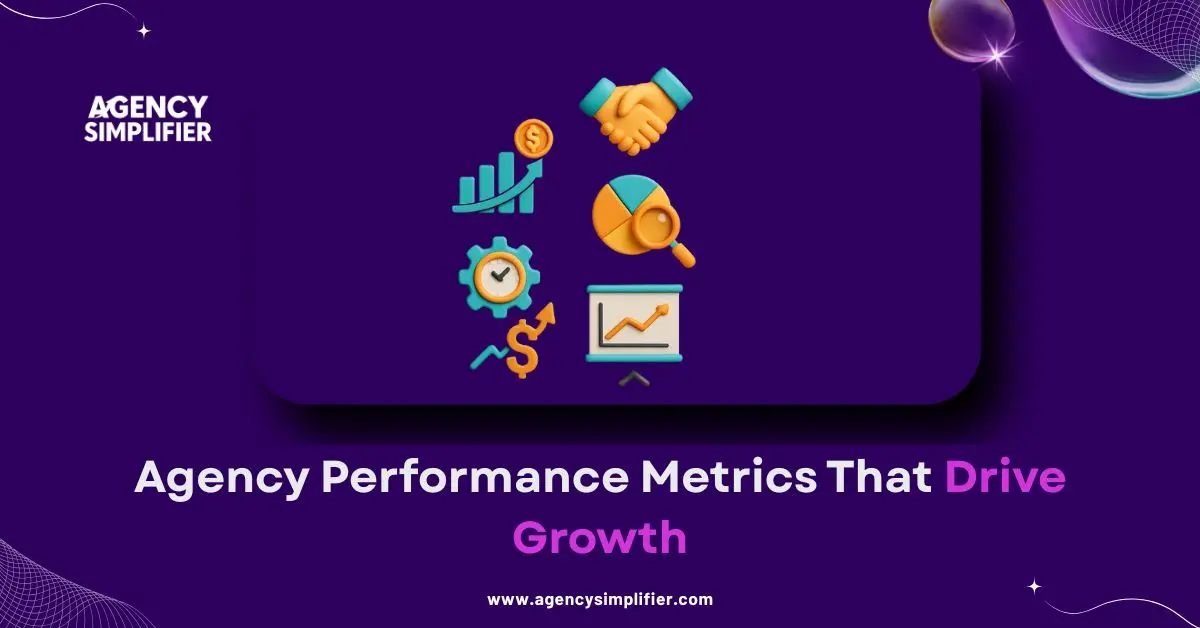
Growth-focused agencies prioritize specific agency KPIs that directly correlate with business expansion and long-term sustainability.
Critical Growth Indicators:
- Client Retention Excellence: The most significant predictor of sustainable growth, as retained clients provide predictable revenue streams and expansion opportunities
- Average Client Lifetime Value: Provides insights into relationship profitability and enables strategic client acquisition investment decisions
- Project Margin Optimization: Reveals which services and client segments generate optimal profitability for resource allocation strategies
- Billable Utilization Efficiency: Indicates how effectively organizations convert available capacity into revenue-generating activities
- Revenue per Employee Productivity: Measures organizational efficiency and identifies opportunities for operational optimization and growth scaling
- Campaign Profitability Analysis: Enables strategic service offering optimization and client segment prioritization decisions
These growth-oriented agency performance metrics enable strategic decision-making that supports sustainable expansion while maintaining service quality and client satisfaction standards.
Advertising Agency Metrics: What Sets Them Apart
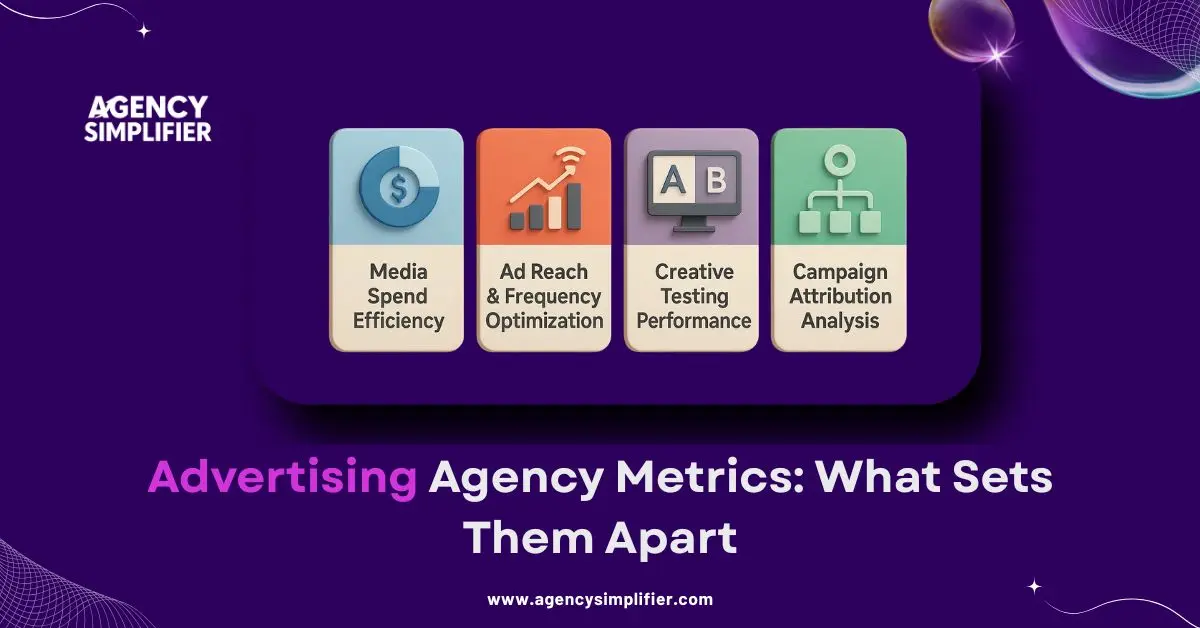
Advertising agencies require specialized measurement frameworks that reflect their unique business models and client service requirements.
Specialized Advertising Metrics:
- Media Spend Efficiency: Evaluates how effectively agencies deploy client advertising budgets across multiple channels and platforms
- Ad Reach & Frequency Optimization: Measures campaign delivery effectiveness and audience engagement without oversaturation
- Creative Testing Performance: Enables systematic validation of creative concepts and optimization of campaign elements through A/B testing methodologies
- Campaign Attribution Analysis: Provides comprehensive customer journey mapping and demonstrates full advertising investment impact
These specialized advertising agency metrics focus on campaign effectiveness, media investment optimization, and creative performance validation, distinguishing advertising agencies from other agency service categories.
Avoiding Vanity Metrics: What Not to Track
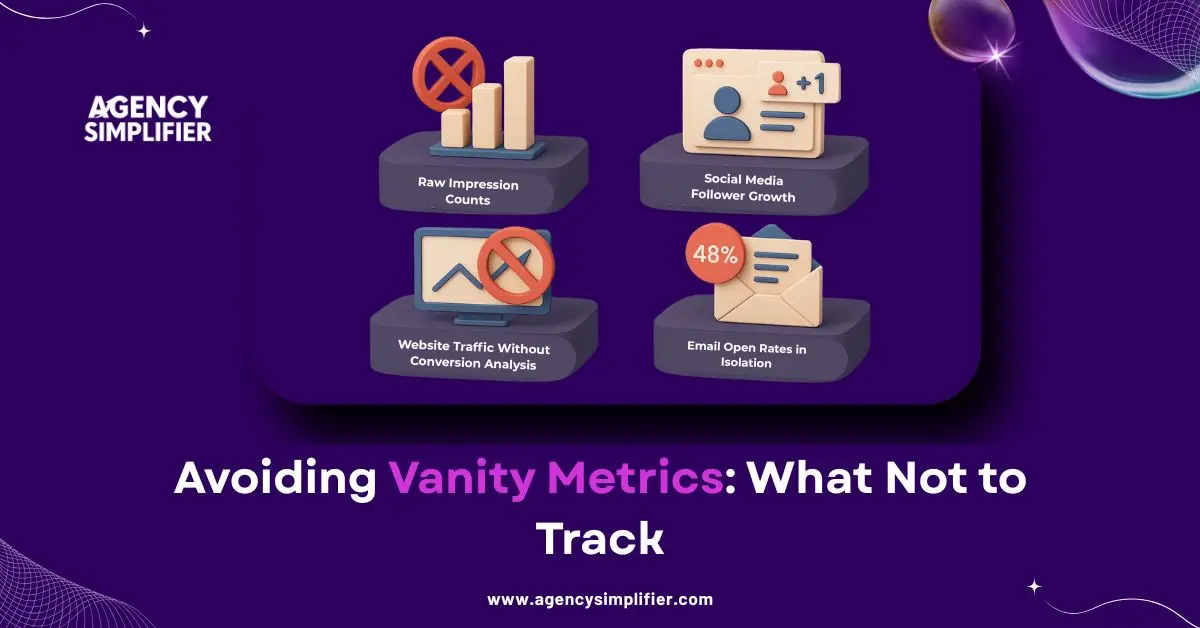
Vanity metrics create performance illusions without providing actionable insights for strategic improvement or business growth.
Common Vanity Metrics to Avoid:
- Raw Impression Counts: High numbers without engagement context or conversion correlation
- Social Media Follower Growth: Quantity-focused metrics without engagement quality or business impact analysis
- Website Traffic Without Conversion Analysis: Volume metrics that don’t correlate with business objectives or revenue generation
- Email Open Rates in Isolation: Surface-level engagement metrics without conversion or revenue attribution
Focus on actionable agency performance metrics that enable decision-making and provide clear direction for optimization efforts. Effective measurement frameworks emphasize quality insights over quantity of data points.
Successful agencies maintain disciplined measurement practices that support strategic decision-making rather than overwhelming stakeholders with superficial performance indicators that don’t drive meaningful business outcomes.
Setting Up Effective KPI Dashboards & Reporting
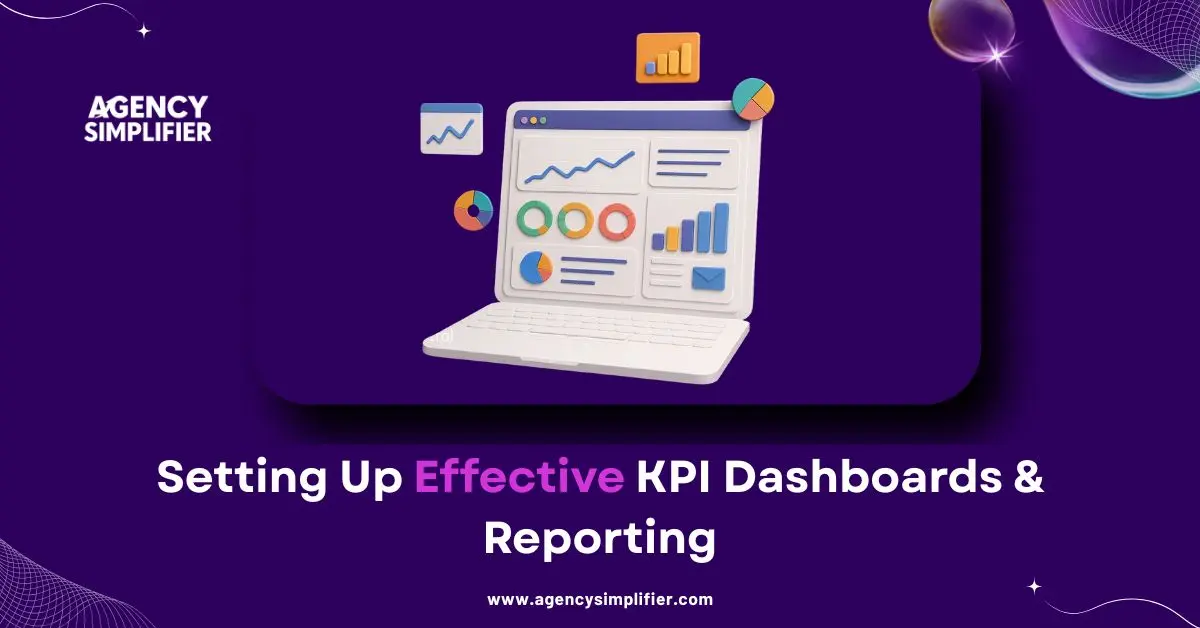
Dashboard architecture significantly impacts measurement system effectiveness and stakeholder engagement with performance data.
Dashboard Design Best Practices:
- Strategic Metric Prioritization: Surface the most critical agency KPIs prominently while maintaining comprehensive visibility into supporting metrics
- Visual Clarity & Trend Analysis: Provide clear visual representations of performance trends that enable quick identification of areas requiring attention
- Automated Data Integration: Leverage integration tools and APIs to consolidate data from multiple platforms into unified reporting systems
- Stakeholder-Specific Customization: Design different dashboard views for client-facing reports versus internal operational analysis
Implementation Strategies:
- Real-Time Data Processing: Implement systems that provide current performance visibility for immediate decision-making capabilities
- Data Validation & Quality Control: Establish processes that ensure measurement accuracy and consistency across all tracking methodologies
- Regular Review & Optimization: Schedule consistent dashboard evaluation sessions to maintain alignment with evolving strategic objectives
Effective dashboard systems balance comprehensive data visibility with usability, ensuring that stakeholders can quickly access relevant insights without overwhelming complexity.
Common Mistakes Agencies Make with KPIs & Metrics
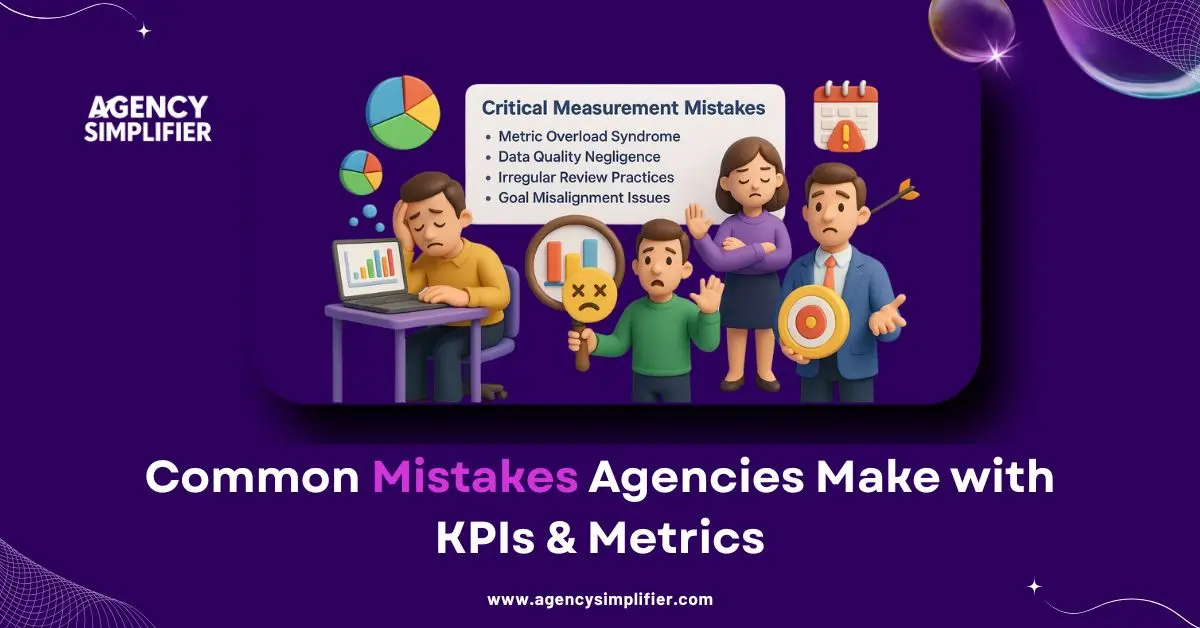
Understanding common measurement pitfalls enables agencies to avoid costly mistakes that undermine performance tracking effectiveness.
Critical Measurement Mistakes:
- Metric Overload Syndrome: Tracking excessive quantities of metrics creates analysis paralysis and dilutes focus from strategic priorities
- Data Quality Negligence: Inconsistent tracking methodologies and validation processes compromise measurement reliability and decision-making accuracy
- Irregular Review Practices: Sporadic KPI analysis reduces measurement impact and misses optimization opportunities for performance improvement
- Goal Misalignment Issues: Disconnection between agency KPIs and client objectives creates satisfaction gaps and relationship tension
Avoidance Strategies:
- Maintain focused measurement frameworks that emphasize critical success indicators over comprehensive data collection
- Establish consistent data validation protocols and tracking methodologies for reliable performance insights
- Implement structured review schedules with accountability frameworks for consistent measurement analysis
- Regularly validate alignment between measurement systems and both agency and client strategic objectives
Top Tools for Tracking Agency KPIs & Metrics
![]()
Selecting appropriate measurement tools significantly impacts agency performance tracking effectiveness and operational efficiency.
Comprehensive Agency Management Platforms:
- Agency Simplifier All-in-one platform featuring customizable client dashboards for comprehensive agency KPI tracking, real-time financial monitoring, project margin analysis, and team utilization optimization. Integrates seamlessly with accounting and CRM systems for unified reporting capabilities.
- Scoro Business Management Unified project management, financial oversight, and resource allocation system with advanced reporting capabilities and customizable KPI dashboards for operational excellence.
- BigTime Project Intelligence Comprehensive project tracking, resource planning, and financial management platform with sophisticated reporting tools for agency performance optimization.
- Workamajig Creative Operations Integrated accounting, project management, and resource allocation system with custom KPI dashboard capabilities designed specifically for creative agencies.
- Function Point Business Intelligence Specialized solution for creative agencies featuring deep business intelligence analytics and comprehensive KPI tracking across all operational dimensions.
Each platform offers unique capabilities for monitoring and optimizing agency performance metrics, enabling organizations to select solutions that align with their specific operational requirements and strategic objectives.
Conclusion
Implementing comprehensive agency KPI and metric tracking systems represents the foundation for sustainable growth and competitive advantage in 2025’s dynamic marketplace. Organizations that prioritize financial performance monitoring, operational efficiency measurement, project management excellence, and client relationship optimization will outperform competitors and build stronger, more profitable partnerships.
The strategic value of measurement extends beyond performance tracking to encompass strategic decision-making, resource optimization, and client value demonstration. Agencies equipped with sophisticated measurement frameworks can adapt quickly to market changes, identify growth opportunities, and maintain competitive positioning through data-driven excellence.
Success requires commitment to measurement discipline, regular system optimization, and alignment between tracking frameworks and strategic objectives. Review your current measurement practices, implement the frameworks outlined in this guide, and establish a culture of data-driven decision-making that supports long-term agency success.
Modern agencies that embrace comprehensive measurement while maintaining focus on critical success indicators will achieve sustainable growth, improved client outcomes, and market leadership through operational excellence and strategic clarity.
Frequently Asked Questions
Q1. What’s the difference between Marketing Agency Metrics and KPIs?
Ans: Marketing agency metrics represent comprehensive data measurements across all operational activities, while KPIs (Key Performance Indicators) are strategically selected metrics that directly correlate with specific business objectives and success criteria. KPIs provide actionable insights for strategic decision-making, whereas metrics offer broader performance visibility.
Q2. How often should agencies review KPIs?
Ans: Review frequency should align with metric impact on operational decisions. Critical operational metrics require daily monitoring, campaign performance KPIs benefit from weekly analysis, and strategic growth metrics need monthly comprehensive evaluation. Fast-moving campaigns or projects may require more frequent assessment cycles.
Q3. What are the best KPIs for agency growth?
Ans: The most impactful growth-oriented KPIs include client retention rates, project profitability margins, revenue per employee productivity, average client lifetime value, and billable utilization efficiency. These metrics provide insights into both operational effectiveness and business expansion opportunities.
Q4. How to measure agency performance comprehensively?
Ans: Comprehensive agency performance measurement requires balanced frameworks incorporating financial metrics (revenue growth, profit margins), operational indicators (utilization rates, project delivery), client satisfaction measurements (NPS scores, retention rates), and campaign performance analytics (ROAS, conversion rates) across all service offerings and client relationships.
Shripad Deshmukh
Shripad Deshmukh, founder of Agency Simplifier, brings over 15 years of experience in custom SaaS development and product management. With a strong focus on digital transformation and multi-platform customer experiences.